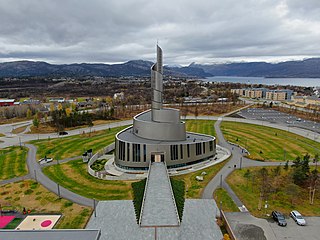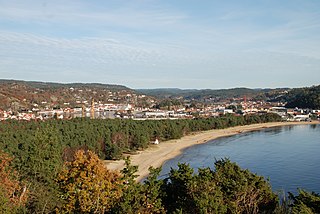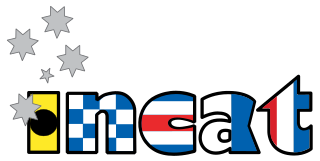A hydrofoil is a lifting surface, or foil, that operates in water. They are similar in appearance and purpose to aerofoils used by aeroplanes. Boats that use hydrofoil technology are also simply termed hydrofoils. As a hydrofoil craft gains speed, the hydrofoils lift the boat's hull out of the water, decreasing drag and allowing greater speeds.

Alta is the most populated municipality in Finnmark in Troms og Finnmark county, Norway. The administrative centre of the municipality is the town of Alta. Some of the main villages in the municipality include Kåfjord, Komagfjord, Kvenvik, Langfjordbotn, Leirbotn, Rafsbotn, Talvik, and Tverrelvdalen.

Haugesund is a municipality on the North Sea in Rogaland county, Norway. While the population is greater in the neighboring Karmøy municipality, the main commercial and economic centre of the Haugaland region in northern Rogaland and southern Vestland is in Haugesund. The majority of the population of Haugesund lives in the Haugesund urban area in the municipality's southwest. The majority of the municipality outside this area is rural or undeveloped.

Mandal is a former municipality in the old Vest-Agder county, Norway. It was located in the traditional district of Sørlandet. The municipality existed from 1964 until 1 January 2020 when the municipalities of Mandal, Lindesnes, and Marnardal were merged to form a new, larger municipality of Lindesnes in what is now Agder county. Mandal was the southernmost municipality in all of Norway, with the tiny skerry of Pysen being the southernmost point of land in Norway.

A catamaran is a multi-hulled watercraft featuring two parallel hulls of equal size. It is a geometry-stabilized craft, deriving its stability from its wide beam, rather than from a ballasted keel as with a monohull boat. Catamarans typically have less hull volume, smaller displacement, and shallower draft (draught) than monohulls of comparable length. The two hulls combined also often have a smaller hydrodynamic resistance than comparable monohulls, requiring less propulsive power from either sails or motors. The catamaran's wider stance on the water can reduce both heeling and wave-induced motion, as compared with a monohull, and can give reduced wakes.

A trimaran is a multihull boat that comprises a main hull and two smaller outrigger hulls which are attached to the main hull with lateral beams. Most modern trimarans are sailing yachts designed for recreation or racing; others are ferries or warships. They originated from the traditional double-outrigger hulls of the Austronesian cultures of Maritime Southeast Asia; particularly in the Philippines and Eastern Indonesia, where it remains the dominant hull design of traditional fishing boats. Double-outriggers are derived from the older catamaran and single-outrigger boat designs.

Incat Tasmania is an Australian manufacturer of high-speed craft (HSC) catamaran ferries. Its greatest success has been with large, sea going passenger and vehicle ferries, but it has also built military transports and since 2015 it has built smaller river and bay ferries. Based in Derwent Park, a suburb of Hobart, Tasmania, Australia, it was founded by Bob Clifford.
A Surface Effect Ship (SES) or Sidewall Hovercraft is a watercraft that has both an air cushion, like a hovercraft, and twin hulls, like a catamaran. When the air cushion is in use, a small portion of the twin hulls remains in the water. When the air cushion is turned off, the full weight of the vessel is supported by the buoyancy of the twin hulls.
A/S Westermoen Båtbyggeri og Mek Verksted was a shipyard located in Mandal, Norway, who specialized in high speed craft. Under the leadership of Toralf Westermoen in the 1950s, the yard has produced a long range of high speed boat types, such as:

The Westamaran is a pioneer type of passenger transport high speed catamarans developed by Westermoen Hydrofoil in 1973. The craft was highly successful, and introduced a new era of passenger transport along the Norwegian coast and elsewhere.

Toralf Westermoen was a pioneer for the development of high speed craft in Norway. Westermoen was involved in the companies Båtservice Verft, Westermoen Båtbyggeri og Mek. Verksted , Westermoen Hydrofoil and Westamarin , all situated in Mandal.
Stena Line Holland BV is a subsidiary of Stena Line that operates ferry routes between Harwich and Killingholme on the east coast of England and Hook of Holland and Europort in the Netherlands. The head office is in Hook of Holland in the Netherlands. Apart from during the two world wars there has been a continuous service operating between these two countries, initially by the railway companies serving the east coast of England together with Stoomvaart Maatschappij Zeeland a Dutch ferry company. In 1990 Stena Line had purchased both parts and Stena Line Holland BV came into being.

MS Stena Saga is a cruiseferry owned by the Swedish shipping company Stena Line and was operating mainly on their route connecting Oslo, Norway to Frederikshavn, Denmark until March 2020, after that the route was closed down. She was built as MS Silvia Regina in 1981 by Wärtsilä in Turku, Finland, for Rederi AB Svea for use in Silja Line traffic. The ship joined the Stena Line fleet in 1991, originally with the name MS Stena Britannica.

The Sauda class was a class of nine minesweepers and one minehunter in service for the Royal Norwegian Navy from 1953 to 1996. The class was designed at Sparkman & Stephens Inc., New York City, as an improvement of the NYMS class. Five of the vessels were built in the United States, three were built at Westermoen Båtbyggeri og Mek Verksted in Mandal, one at Skaalurens Skibsbyggeri in Rosendal and one at De Forenede Båtbyggerier in Risør. The class was fully financed by the US government as a part of the Military Assistance Program (MAP).
Partsrederiet Kystekspressen ANS branded as Kystekspressen or the Coast Express is a shipping company that operates passenger ferry services between Trondheim and Kristiansund, Norway. Three ships are used on the route, that includes the branch lines Trondheim–Sula and Sistranda–Halten. It had 343,510 passengers in 2005.

One World Karadeniz is a former high-speed ferry that operated Stena Line's Holyhead–Dún Laoghaire service between Great Britain and Ireland until 2015. It is a member of the HSS 1500 class of high-speed ferries introduced and developed by Stena Line from 1996 onwards. The HSS 1500 class vessels became the largest catamarans in service in the world.
MV Mariam is a Bolivian-flagged passenger ferry with a 228 gross tonnage (GT). Built in 1982 at Westermoen Hydrofoil shipyard, the ship is a catamaran 29.00 metres in length with a capacity of about 200 passengers. Built as Venture 84, the ship was in service with the French ferry operator Emeraude Lines from 1983 to 1996, serving a route between the Channel Islands and France. From 1996 to 2008, the ship was operated by Cypriot ferry operator Fergün Denizcilik as Fergün Express III.
Hallvard Trætteberg was the leading Norwegian heraldic artist and the expert adviser on heraldry to the Government of Norway and the Norwegian Royal Family for much of the 20th century. From about 1930 he played a central role in the renewal of public heraldry in Norway with an emphasis on simplification. He gave the Coat of arms of Norway a modern design and designed several county and municipal coats of arms, seals of the bishops of the Church of Norway, and monograms. He also wrote several books.












